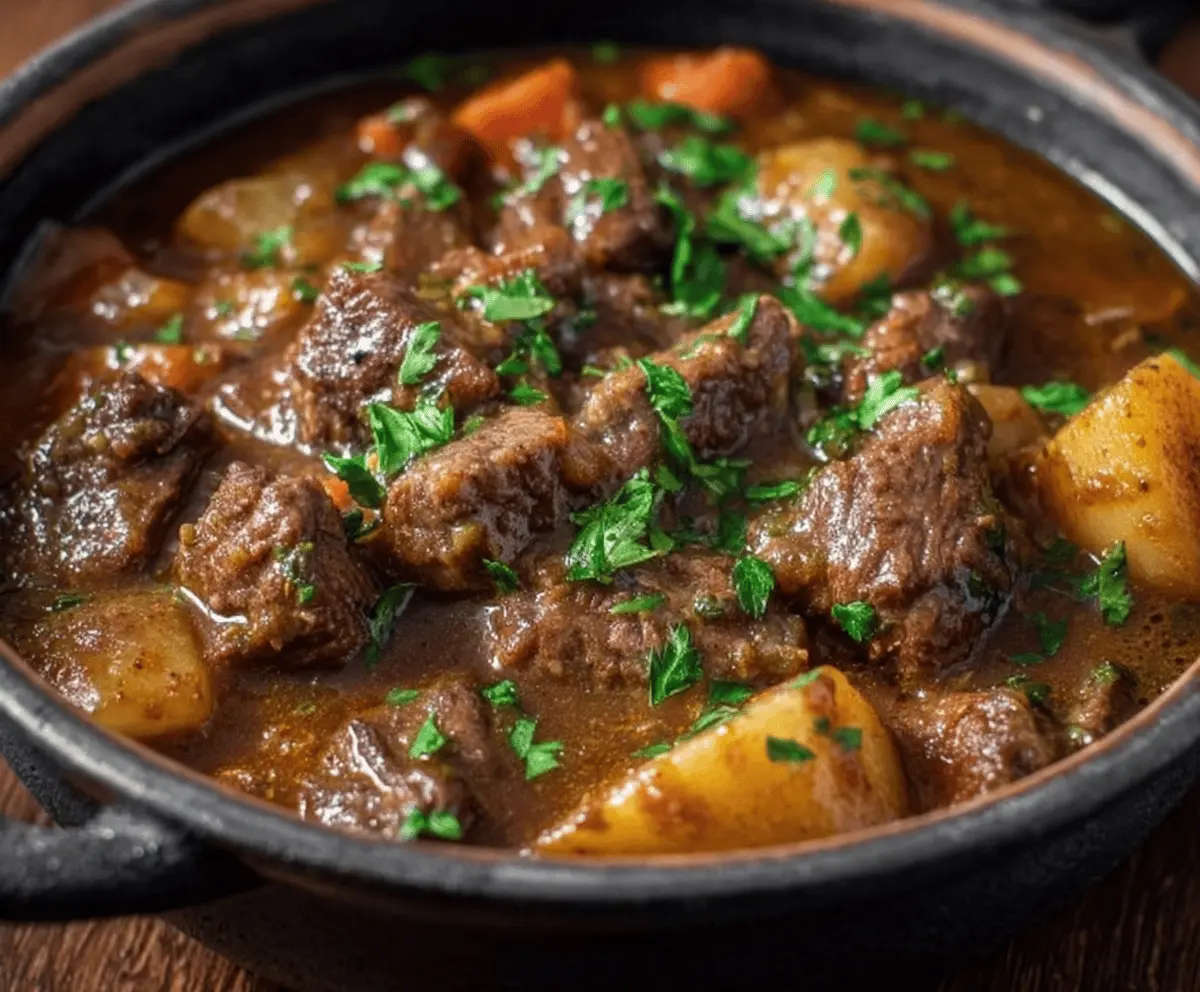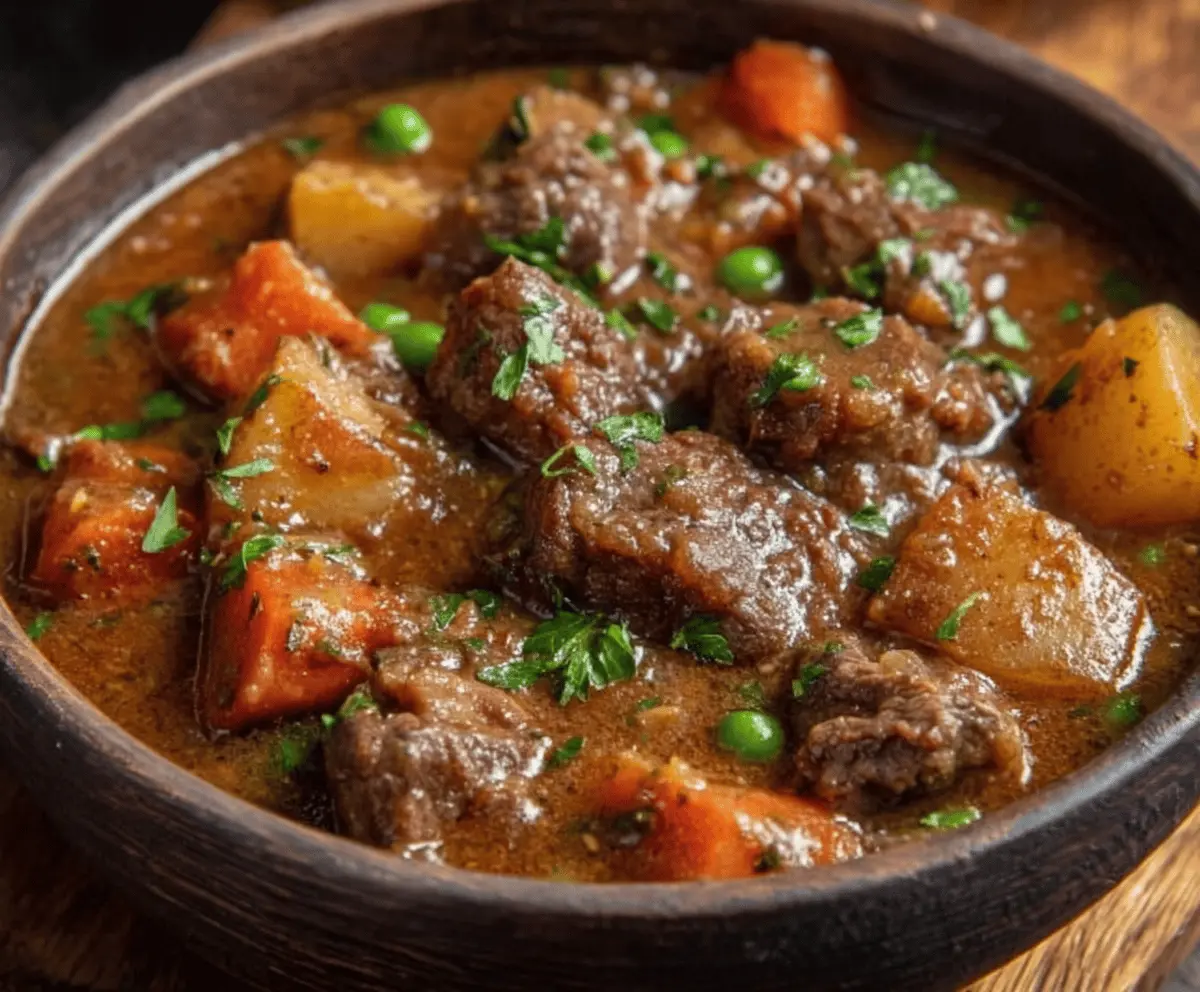Old fashioned beef stew is a hearty, comforting dish that feels like a warm hug on a chilly day. Tender chunks of beef slowly cooked with carrots, potatoes, onions, and a rich, flavorful broth make this stew a classic favorite. The thick, savory sauce clings to every bite, making it both filling and satisfying.
I love making this stew when I have extra time to let it simmer gently on the stove or in the oven. It’s one of those recipes where slow cooking really brings out the best flavors, and the meat becomes so tender it practically melts in your mouth. I always find myself sneaking tastes along the way—it’s just that good!
My favorite way to serve old fashioned beef stew is with a side of crusty bread or over a bed of buttery mashed potatoes. It’s the perfect meal to gather everyone around the table, share stories, and enjoy some simple, cozy comfort food together. This stew always makes the house smell amazing and fills everyone with warm, happy feelings.
Bake, Serve, Wear the Vibe 👕
Editor-picked tees our Oven To Fork readers love.



We may earn from qualifying purchases at no extra cost to you.
Key Ingredients & Substitutions
Beef chuck: This cut works best because it becomes tender and flavorful when slow-cooked. If you can’t find chuck, try brisket or round roast.
Vegetables: Carrots and potatoes give sweetness and body to the stew. Sweet potatoes or parsnips can also add nice flavor. Frozen peas are a simple last-minute green addition.
Tomato paste: It adds depth and a bit of tang. You can substitute with a few tablespoons of ketchup or leave it out if needed.
Broth: Use beef broth for richness, but chicken or vegetable broth work if you want a lighter taste.
How Do You Get Rich Flavor and Tender Meat in Beef Stew?
Start by patting the beef dry and searing it in batches over medium-high heat. Browning the meat well develops deep flavors. Don’t overcrowd the pan, or the meat will steam.
After sautéing onions and garlic, stir in tomato paste and cook briefly to remove any raw taste. Then add the broth and herbs and simmer gently.
Cook the stew slowly over low heat for 1.5 to 2 hours to break down the meat fibers. Add vegetables later so they don’t turn mushy. This slow simmering makes the beef tender and the broth rich.

Equipment You’ll Need
- Heavy-bottomed pot or Dutch oven – perfect for even heat and slow simmering without burning.
- Sharp knife – makes cutting beef and vegetables easier and safer.
- Wooden spoon – great for stirring without scratching your pot.
- Measuring cups and spoons – helps you get seasoning and liquids just right.
- Cutting board – a stable surface to chop veggies and meat safely.
Flavor Variations & Add-Ins
- Swap beef chuck for lamb shoulder for a different but rich taste that also becomes tender slowly.
- Add a splash of red wine during cooking to deepen the flavor profile.
- Include parsnips or turnips with the carrots and potatoes for a sweet, earthy twist.
- Stir in fresh herbs like rosemary or thyme right before serving for a bright, fresh note.

Old Fashioned Beef Stew
Ingredients You’ll Need:
Main Ingredients:
- 2 lbs beef chuck, cut into 1 to 1.5-inch cubes
- Salt and black pepper, to taste
- 2 tablespoons vegetable oil
- 1 large onion, chopped
- 3 cloves garlic, minced
- 4 cups beef broth
- 1 cup water
- 3 large carrots, peeled and cut into chunks
- 3 large potatoes, peeled and cut into chunks
- 1/2 cup frozen peas
- 2 tablespoons tomato paste
- 1 teaspoon dried thyme
- 1 teaspoon dried parsley, plus extra for garnish
- 1 bay leaf
- 1/4 cup all-purpose flour (optional, for thickening)
How Much Time Will You Need?
This recipe takes about 30 minutes for preparation and browning, then around 2 to 2.5 hours for simmering to develop rich flavors and tender beef. Most of the cooking time is hands-off simmering, so you can relax while it cooks low and slow.
Step-by-Step Instructions:
1. Brown the Beef:
Start by patting your beef cubes dry and seasoning generously with salt and pepper. Heat the vegetable oil in a large heavy pot or Dutch oven over medium-high heat. Brown the beef in batches, making sure each piece gets a nice caramelized crust. Remove browned beef and set aside.
2. Cook the Aromatics:
In the same pot, add the chopped onion and sauté for about 5 minutes until soft and transparent. Add the minced garlic and cook for one more minute until fragrant. Stir in the tomato paste and cook for 2 minutes, mixing it well with the onions and garlic.
3. Build the Stew Base:
Return the beef to the pot. If using, sprinkle flour over the meat and stir to coat, which helps thicken your stew later. Pour in the beef broth and water. Add thyme, dried parsley, and bay leaf. Stir everything together and bring it to a gentle boil.
4. Simmer the Stew:
Reduce the heat to low, cover the pot, and let it simmer gently for 1.5 to 2 hours until the beef is tender and flavorful.
5. Add Vegetables:
Add the carrots and potatoes to the pot. Cover and continue to simmer for another 30 to 40 minutes, or until the vegetables are cooked through and tender.
6. Finish and Serve:
Add the frozen peas and cook for 5 more minutes. Remove the bay leaf, then taste the stew and adjust seasoning with salt and pepper if needed. Garnish with freshly chopped parsley before serving.
This stew is perfect served hot with crusty bread or over creamy mashed potatoes for a warm and satisfying meal.
Can I Use Frozen Beef for This Stew?
Yes, but make sure to thaw the beef completely before cooking. Thaw it overnight in the refrigerator or use the defrost setting on your microwave. This helps the beef brown properly and cook evenly.
How Can I Thicken My Beef Stew?
Sprinkling flour over the beef before adding broth is a great way to thicken the stew naturally. Alternatively, you can mix a tablespoon of cornstarch with cold water and stir it in near the end of cooking. Let it simmer a few minutes until thickened.
Can I Make This Stew Ahead of Time?
Absolutely! Beef stew tastes even better the next day as the flavors meld. Store leftovers in an airtight container in the fridge for up to 3 days. Reheat gently on the stove or in the microwave, adding a splash of broth if it’s too thick.
What Can I Substitute for Beef Broth?
If you don’t have beef broth, chicken or vegetable broth can work as substitutes. Keep in mind the flavor will be a bit lighter, but the stew will still be delicious.


